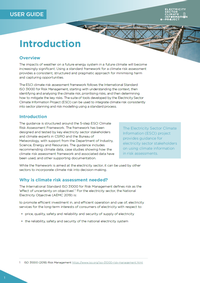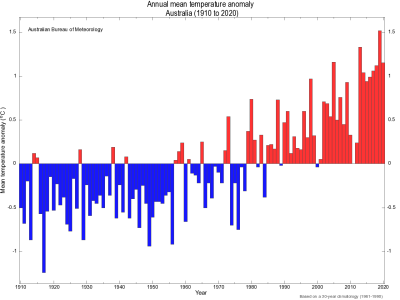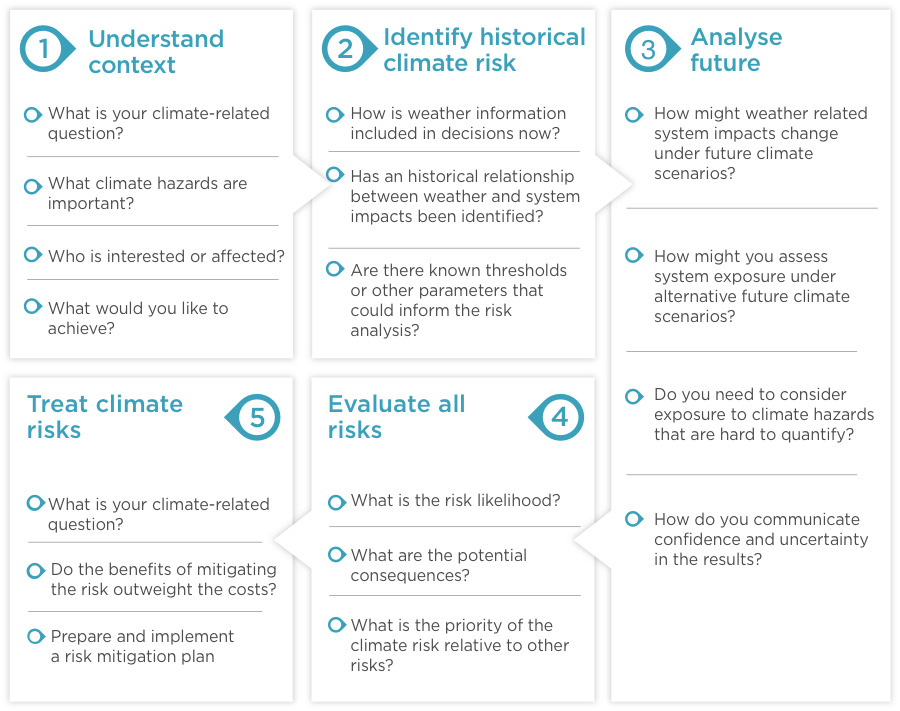Climate Change in Australia
Climate information, projections, tools and data
Risk Assessment - Introduction
DownloadGuidance Introduction
(pdf 1.4 MB)
- Overview
- Introduction
- Why is a climate risk assessment needed?
- Context for using the climate risk assessment framework
- What does the framework cover?
- How should the framework be used?
- References
- Downloads
Overview
The impacts of weather on a future energy system in a future climate will become increasingly significant. Using a standard framework for a climate risk assessment provides a consistent, structured and pragmatic approach for minimising harm and capturing opportunities.
The ESCI Climate Risk Assessment Framework follows the International Standard ISO 31000 for Risk Management, starting with understanding the context, then identifying and analysing the climate risk, prioritising risks, and then determining how to mitigate the key risks. The suite of tools developed by the Electricity Sector Climate Information Project (ESCI) can be used to integrate climate risk consistently into sector planning and risk modelling using a standard process.
Introduction
The Electricity Sector Climate Information (ESCI) project provides guidance for electricity sector stakeholders on using climate information in risk assessments.
The guidance is structured around the five-step ESCI climate risk assessment framework. The framework has been designed and tested by key electricity sector stakeholders and climate experts in CSIRO and the Bureau of Meteorology, with support from the Department of Industry, Science, Energy and Resources. The guidance includes recommending climate data, case studies showing how the climate risk assessment framework and associated data have been used, and other supporting documentation.
While the framework is aimed at the electricity sector, it can be used by other sectors to incorporate climate risk into decision-making.
Why is a climate risk assessment needed?
The International Standard ISO 31000 for Risk Management defines risk as the 'effect of uncertainty on objectives'.1 For the electricity sector, the National Electricity Objective (AEMC 2019) is:
- to promote efficient investment in, and efficient operation and use of, electricity services for the long-term interests of consumers of electricity with respect to:
- price, quality, safety and reliability and security of supply of electricity
- the reliability, safety and security of the national electricity system
Context for using the climate risk assessment framework
Figure 1 All parts of the electricity sector, from generation to transmission and supply to demand, are sensitive to heat. Increasing average and extreme temperatures due to climate change present an operating environment different from the past. (Source: Bureau of Meteorology Climate change and variability: Tracker: Australian timeseries graphs )
There is clear evidence that the climate has been changing (BoM and CSIRO 2020). Australia has warmed by 1.4 oC since 1910 (Figure 1), with less rainfall in the south and east and more rainfall in the north. Impacts on the electricity system have been felt through extreme weather events such as heatwaves, floods, wind-storms, droughts and fires.
Climate change is creating new risks for businesses (Table 1). For example, high temperatures increase electricity demand and affect all electricity supply infrastructure; as temperatures rise with climate change, the risks to the sector will also rise.
Potential applications of a climate risk assessment include:
- prioritising climate risks that require mitigation
- managing asset safety and reliability risks managing the potential for asset or value destruction
- managing the potential for changes in cash flow or profitability
- managing consumer outcomes from the integrated power system
- designing new asset specifications for future operating conditions
- calculating market benefits attributable to regulated investments
- considering changes to operating conditions of the integrated power system
Climate change is superimposed on natural weather and climate variability, and while historical records provide a good indication of emerging risks, future risks are likely to be underestimated or may appear in new locations. Climate risks to the electricity sector are likely to be most relevant in strategic or planning time frames (5–50 years). However, some impacts are already evident and are relevant to operational time frames (1–5 years).
Physical Risks Electrical assets are likely to be affected by weather that differs from the historical expectation. Physical risks include:
This category is the focus of the ESCI project |
||
|---|---|---|
Supply-side transition risks As part of global greenhouse gas emission reductions and changing technology prices, electricity generation is transitioning from fossil fuels to renewable sources such as wind and solar. The intermittent nature of these sources affects the operability of systems, as well as transmission needs, reliability, system stability, strength, fault levels and synchronous support. |
Demand-side transition risks Climate change and decarbonisation will affect electricity users and their needs. Impacts to residential consumption may include additional rooftop PV and electric vehicles. Impacts to business consumption may include additional desalination, further restructuring of the economy and changing agricultural and industrial needs. |
Institutional risks Failure of sector institutions and organisations to consider climate change will produce financial, legal, governance and reputational impacts. |
What does the framework cover?
The framework covers the analysis of physical climate risks, defined by the Intergovernmental Panel on Climate Change (IPCC) as the combination of hazards, exposure and vulnerability (Cardona et al. 2012). Exposure is the presence of people; livelihoods; species or ecosystems; environmental functions, services, and resources; infrastructure; or economic, social, or cultural assets in places and settings that could be adversely affected by a hazard. Vulnerability refers to the propensity of assets, systems and consumers to experience adverse effects. This may be the result of design or engineering, or the inability to adapt, such as a community not being able to move out of the way of a hazard such as a fire or flood.
The ESCI project provides information on the intensity and frequency of weather and climate hazards.2 For a complete risk assessment, exposure and vulnerability need to be considered. For example, the National Energy Market (NEM) has long interconnectors between population, industrial and other demand centres. Thus, the NEM is widely exposed to extreme weather events, climate variability and climate change.
The ESCI Climate Risk Assessment Framework has five steps (Figure 2).
How should the framework be used?
Risk assessment is an iterative process. Depending on the work your organisation has undertaken on climate risks, the risk management processes involved and the objectives and resources available, the climate risk assessment may range from simple to complex. You should start with a simple, rapid and qualitative assessment to prioritise where detailed effort may be needed in a subsequent assessment, also referred to as a ‘scan cycle’ (CSIRO 2018). If this has already been completed, you may wish to undertake a more comprehensive assessment. It is unlikely that you will work sequentially through each step in the method. You will probably repeat some steps as you develop your understanding of climate risks and fine-tune your objectives.
The ESCI project user guidance includes detailed information on the assessment framework steps and how to integrate historical and projected climate information. ESCI case studies provide worked examples of using the climate risk assessment framework to assess exposure to future risk.
The steps of the ESCI project user guidance include detailed information for each of the framework steps.
The ESCI website provides access to high resolution climate projection data: (i.e. 1.5–12 km) across the NEM, at sub-daily intervals, to 2100. It includes insights which enable users to choose appropriate data and to plan for this future with greater confidence
ESCI case studies show how the tools available on the website have been used in a climate risk assessment—accompanying documents step through the case study process in detail. Note: every business, location and asset combination is different, so the case studies do not provide a comprehensive overview of electricity system vulnerabilities and should not be used be used to inform operational decision-making.
Key concepts provide as-needed insights into climatology concepts used in analysing climate risk, as well as information on how the climate data were evaluated and the recommended data sets chosen.
The ESCI website: climatechangeinaustralia.gov.au/esci-project-home/esci-home
Figure 2 The ESCI Climate Risk Assessment Framework.
References
AEMC (2019). Applying the energy market objectives (PDF )
BoM and CSIRO (2020). State of the Climate
Cardona OD, van Aalst OD, Birkmann J, et al. (2012). Determinants of risk: exposure and vulnerability. In: IPCC Managing the Risks of Extreme Events and Disasters to Advance Climate Change Adaptation. A Special Report of Working Groups I and II of the Intergovernmental Panel on Climate Change (IPCC) (eds Field CB, Barros V, Stocker TF, et al.) Cambridge: Cambridge University Press, 65–108.
CSIRO (2018) Climate Compass: A climate risk management framework for Commonwealth agencies . CSIRO Australia.
Energy Networks Australia (2014) Climate Risk and Resilience - Industry Guidance Manual
. ENA DOC 036-2015. Energy Networks Australia.
Notes
1 ISO 31000 (2018) Risk Management
2 Note, a hazard could be a change in a climate variable—for example, temperature is a variable, but an extreme temperature is a hazard.
Downloads
DownloadIntroduction and all figures (zip 1.7 MB)






